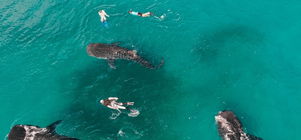How we built our tree houses
"Anne and I were drawn to Chole by the dhows built on the island by fundis, rumoured to the best in East Africa. We commissioned one, and while our dhow took shape, fell irrevocably in love with the island, its wonderful people, and the waters that surround it. The District Authorities, who didn’t encounter many wazungu in those days, somehow thought we were investors, and offered us a site on Chole to develop a hotel, even though Anne and I knew absolutely nothing about the business of hotels!
We had plenty of ideas, especially around how tourism could improve the lives of the Chole villagers, but no ambition to build a hotel until a serendipitous encounter with Emerson, who created Zanizbar’s first boutique hotel, led to a plan whereby he would build and ultimately run one on Chole. We started the company in 1993, but remained involved at arm’s length until 1996, when our partner – who by that time had built little more than a camp site on Chole – lost all interest in hotels, and sank all available resources into producing a film and founding the Zanzibar International Film Festival. Having sunk a fair amount of capital into the Chole project, and having already begun with construction of the primary school and thereby raised everyone’s hopes, Anne and I just couldn’t drop the whole project. And so we decided to move to Chole for a year or two and build the kind of place that we would have liked to find on first arriving in such a beautiful place. Something simple yet at the same time elegant and comfortable. We wanted it to be appropriate to the site and blend in with the bush, ruins and mangrove forest, be open to nature but still secure and able to withstand the occasional tropical storm. We wanted it to reflect ourselves, the kind of people we think we are, or would like to be.
We decided to sell the generators our partner had purchased and forego power tools; to build slowly and only with local skills, labour and materials, so that almost all our development capital would be spent on Chole Island.
With only architect’s preliminary sketches and no proper drawings, technical specifications or engineering experience to rely on, I had to make it up as I went along, making mistakes, modifications, endless sketches and sucking the stress calculations out of a past interest in mathematics, cajoling and fighting with the fundis in extremely poor Kiswahili. The concepts of vertical, horizontal, parallel, square, level and plumb are all completely irrelevant to building dhows and also all described by just a single word, sawa, which also means okay, or good! I spent many sleepless nights trying to figure out a problem, constantly reminded that in all my years at school I only ever failed woodwork and technical drawing, and that my previous education and professional life spent designing and synthesizing molecules that are too small ever to be seen by human eyes, in sophisticated laboratories with cutting edge technologies, had been a less than ideal preparation for building overscaled wooden houses in the trees on a remote tropical island utilizing craftsmen that are extremely skilled at something else, hand tools I’d only ever seen in books before and the need to communicate in a foreign language to make it all sawa.
While I was serving an apprenticeship in my new trade as a builder of tree houses, Anne was (in between going off to places like Liberia and the Chalbi Desert of Kenya to do paid consultancies to support us) doing the really difficult work of building bridges and relations with the villagers via the many different community development projects we had initiated, getting the primary school and hospital completed, staffed and up and running, clearing bush and landscaping, sorting through the mountain of unfinished, unfiled and often unintelligible, half-rotten paperwork left by our anarchic predecessor, training islanders with no formal schooling to work in a hotel and bringing up and teaching our four-year-old hero Didier and our newborn sweetheart, Maya.
Each tree house took from six months to a year to complete because they were built completely by hand, using traditional tools and utilizing materials sourced only from traders living on Chole. Time slipped away, to bureaucracy, to malaria and hepatitis and the universal building plague. Like builders the world over, the Chole fundis constantly had other (usually boat building) jobs to be dealt with on the side and there were the many arguments about money and whose fault it was when the building materials weren’t at hand when needed. We only bought poles and wood that were accompanied by a valid license from the appropriate authority, which slowly excluded many suppliers, and in the end most of the poles and wood came from the nearby Rufiji River delta and one man who has become a very dear friend. Abdullah Mzee is a human dynamo, a mover and shaker who has saved our butts on more than one occasion over the years. Each tree for poles and planks was cut by hand, sawn into planks by hand in a saw pit and transported to Chole by dhow, cured by us for at least twelve months and then ripped and planed by hand. I’m happy that his efforts on our behalf paid for him to go on the Hajj, the greatest wish of this remarkable man, and the only man on Chole to have done so.
Slowly but surely the houses took shape, and four years later we were ready to receive our first guests, thanks to the immense skill and raw intelligence of the boat-builders of Chole, who turned my often less than practical ideas into reality: “Sawa na asanteni wafundi Ali Kingi, Mzee Mbuyu, Mzee Abdurahman, Farahani na Rashidi.”




Share This Page